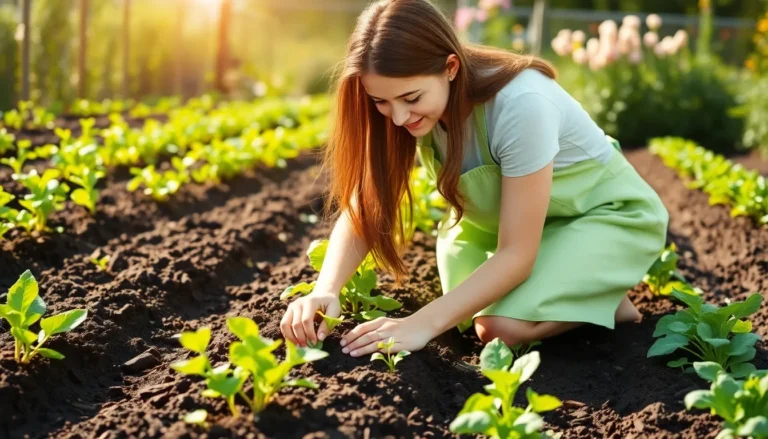Spring’s just around the corner, and if you’re in Missouri, it’s time to dust off those gardening gloves and get ready to unleash your inner farmer. But before you dive headfirst into the dirt, knowing when to plant those veggies is crucial. After all, nobody wants to be that person who tries to grow tomatoes in a snowstorm.
A vegetable planting calendar for Missouri is your best friend in this leafy adventure. It’s like having a GPS for your garden, guiding you to the best planting times for everything from luscious lettuce to robust radishes. With a little planning and the right timing, you’ll be harvesting fresh produce that’ll make your neighbors green with envy—pun intended! So grab a seat, and let’s dig into the essentials of planting in the Show-Me State.
vegetable planting calendar missouri
A vegetable planting calendar is essential for successful gardening in Missouri. It provides specific planting dates based on local climate conditions, helping gardeners avoid frost damage. Understanding when to plant different vegetables enhances growth and maximizes yields.
Planning ahead using a calendar aids in staggering crops, ensuring a continuous supply of fresh produce throughout the growing season. Shedding light on ideal planting times allows gardeners to synchronize with seasonal changes. Knowing when to sow seeds or transplant seedlings maximizes the chances of thriving plants.
Gardeners benefit from organized planting schedules. Adhering to a calendar reduces uncertainty and enhances efficiency. Marking dates for specific crops helps keep track of seasonal tasks like watering and fertilizing.
Choosing the right time for planting not only influences individual plants but can also impact the overall garden ecosystem. Timing affects pollination, pest control, and nutrient availability. A well-established calendar promotes healthy interactions among plants, benefiting community gardening efforts.
Utilizing a planting calendar assists novice and experienced gardeners alike. Beginners gain confidence by following a clear guide, while seasoned gardeners can optimize their planting strategies. Adapting to Missouri’s unique growing conditions is easier with accurate timing.
A vegetable planting calendar serves as a foundational tool for gardening success. Each planting date marks an opportunity for gardeners to cultivate a bountiful harvest. Embracing this resource ultimately supports sustainable gardening practices in Missouri.
Understanding Missouri’s Climate

Missouri’s climate significantly impacts vegetable planting. To maximize yield, it’s essential to grasp local conditions.
Hardiness Zones
Missouri encompasses several hardiness zones, primarily ranging from 5b to 7a. Zone 5b experiences minimum temperatures of -15 to -10 degrees Fahrenheit, suitable for cold-hardy vegetables. Conversely, Zone 7a allows planting of heat-loving crops, thriving in milder winters. Identifying the specific zone helps gardeners select appropriate plant varieties, accommodating seasonal growth patterns. Zone maps provide useful guidance in this process, enabling effective vegetable selection tailored to location. Successful planting aligns with the characteristics of each zone, ensuring resilience and productivity.
Seasonal Weather Patterns
Seasonal weather patterns in Missouri vary significantly throughout the year. Summers can be hot and humid, ideal for growing crops like tomatoes and peppers. In contrast, winters produce colder temperatures with potential frost, necessitating caution for early spring planting. Rainfall occurs throughout different seasons, influencing soil moisture levels and planting schedules. Early spring may bring unpredictable weather, while autumn often showcases a gradual cool-down. Understanding these patterns assists gardeners in timing their planting, aligning with the state’s seasonal transitions. Effectively navigating weather fluctuations provides essential insights for maintaining a productive garden.
Key Vegetables For Missouri
Missouri gardeners benefit from selecting the right vegetables according to the state’s climate. Understanding which crops thrive during certain seasons is essential for a successful garden.
Cool-Season Crops
Cool-season crops flourish in early spring and fall. Examples include lettuce, spinach, and radishes. These vegetables tolerate frost, making them ideal for planting in March or April. Gardeners can also replant them in late summer for a fall harvest. Soil temperatures between 45°F and 75°F support their growth, ensuring good yields. Cold-tolerant varieties, like kale and peas, offer additional options for maximizing harvests during cooler months.
Warm-Season Crops
Warm-season crops thrive in the heat of summer. Tomatoes, peppers, and corn stand out among popular choices in Missouri gardens. These plants require soil temperatures of at least 60°F for optimal growth. Planting typically occurs after the last frost date, around mid-May. Sunlight becomes crucial, as these vegetables need full sun to mature properly. Staggering planting times can extend growing seasons, offering continual harvests throughout the summer. Knowing these specifics enhances the overall garden experience.
Monthly Planting Guide
A monthly planting guide offers specific vegetable planting times tailored for Missouri’s climate. Here’s a breakdown of optimal planting periods.
January to March
January marks the beginning of the gardening season for early preparations. Focus on starting seeds indoors, including tomatoes and peppers, which benefit from a head start. By late March, cold-tolerant plants like peas and onions can be sown directly into the garden. Managing soil temperature becomes crucial, as early planting helps ensure robust growth.
April to June
April brings warmer temperatures, providing ideal conditions for planting warm-season crops. Direct sow beans, cucumbers, and sweet corn in mid-April, after the last frost. May sees an increase in planting options, making it ideal for squash and peppers. Consistent watering and nutrient management during these months support optimal crop development.
July to September
July requires careful attention to crops and potential heat stress. Plant late-season vegetables such as kale and turnips early this month to maximize growth before autumn. August is an ideal time to start fall crops, including broccoli and Brussels sprouts. September focuses on harvesting and preparing soil for the next planting cycle, utilizing cover crops to improve soil health.
October to December
October emphasizes harvesting remaining crops and preparing the garden for winter months. This period allows for planting garlic and shallots, ensuring they establish before winter dormancy. November may involve final soil amendments for spring planting. December typically entails planning for the next season and organizing seed orders, setting the stage for future gardening success.
Tips For Successful Vegetable Gardening
Gardeners should select healthy, disease-resistant seeds to start their gardening journey. Soil preparation comes next, as ensuring rich, well-draining soil leads to robust plants. Fertilizing the soil with organic matter enhances nutrient availability, supporting optimal growth.
Watering is crucial, especially during dry spells. Consistent, deep watering promotes strong root development and resilience against pests. Mulching around plants helps retain moisture and suppress weeds, making maintenance easier.
Crop rotation plays a vital role in soil health. Changing plant locations each season minimizes pest buildup and nutrient depletion. Companion planting can also benefit garden ecosystems, as some plants, like marigolds, deter pests that attack vegetables.
Monitoring for pests and diseases is essential. Early intervention allows for effective control, ensuring a healthy crop. Gardeners should be aware of common pests specific to Missouri, such as aphids and squash bugs.
Timing plays an integral role in gardening success. Utilizing the vegetable planting calendar aids in planting at the right time, avoiding frost or extreme heat. Periodic assessments of plant growth inform whether adjustments are necessary throughout the season.
Finally, keeping detailed records encourages improved gardening practices. Tracking planting dates, yields, and challenges helps refine future gardening strategies. By following these tips, gardeners enhance their chances of enjoying a plentiful harvest in Missouri.
Conclusion
Utilizing a vegetable planting calendar is key for gardeners in Missouri aiming for a successful growing season. By understanding local climate conditions and hardiness zones, they can choose the right crops and optimal planting times. This strategic approach not only enhances plant growth but also promotes a healthier garden ecosystem.
Embracing the tips and guidelines provided ensures that gardeners can navigate seasonal challenges effectively. With careful planning and attention to detail, they’ll enjoy a continuous supply of fresh produce throughout the year. The journey of gardening becomes more rewarding when one is equipped with the right knowledge and resources.




